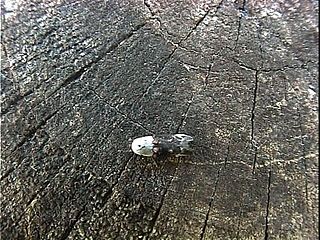Related Research Articles

Trachypepla euryleucota is a species of moth in the family Oecophoridae. It is endemic to New Zealand and can be found throughout the country. They inhabit native forest and the larvae are leaf litter feeders and have also been found feeding on and in bird nests. Adults are on the wing from December to March, are nocturnal and are attracted to light. During the daylight hours they can be sometimes be observed resting on walls or fences. It has been hypothesised that the adults resemble an opening manuka flower bud or bird droppings in order to camouflage themselves from predators. The raised tufts on their forewings possibly also assist with camouflaging this moth when they rest on lichen.
Heterocrossa gonosemana is a species of moth in the family Carposinidae. It is endemic to New Zealand.
Microcolona leucochtha is a moth in the family Elachistidae. It was described by Edward Meyrick in 1897. It is found in Australia, where it has been recorded from New South Wales and South Australia.
Microcolona nodata is a moth in the family Elachistidae. It was described by Edward Meyrick in 1897. It is found in Australia, where it has been recorded from New South Wales, Western Australia and Tasmania.
Microcolona sollennis is a moth in the family Elachistidae. It was described by Edward Meyrick in 1897. It is found in Australia, where it has been recorded from New South Wales.
Microcolona thymopis is a moth in the family Elachistidae. It was described by Edward Meyrick in 1897. It is found in Australia, where it has been recorded from New South Wales.
Catacometes hemiscia is a moth in the family Oecophoridae. It was described by Edward Meyrick in 1883. It is found in Australia, where it has been recorded from New South Wales.
Garrha cholodella is a moth in the family Oecophoridae. It was described by Edward Meyrick in 1883. It is found in Australia, where it has been recorded from New South Wales.
Garrha costimacula is a moth in the family Oecophoridae. It was described by Edward Meyrick in 1883. It is found in Australia, where it has been recorded from Queensland and New South Wales.
Garrha leucerythra is a moth in the family Oecophoridae. It was described by Edward Meyrick in 1883. It is found in Australia, where it has been recorded from New South Wales and Tasmania.
Gnathifera opsias is a moth in the family Epermeniidae. It was described by Edward Meyrick in 1897. It is found in Australia, where it has been recorded from Tasmania.
Dichomeris oxygrapha is a moth in the family Gelechiidae. It was described by Edward Meyrick in 1913. It is found in South Africa and Mozambique.
Dichomeris zygophorus is a moth in the family Gelechiidae. It was described by Edward Meyrick in 1904. It is found in Australia, where it has been recorded from Queensland.
Symbolistis orophota is a moth in the family Gelechiidae. It was described by Edward Meyrick in 1904. It is found in Australia, where it has been recorded from southern Queensland and New South Wales.
Hypatima attenuata is a moth in the family Gelechiidae. It was described by Edward Meyrick in 1920. It is found in Australia, where it has been recorded from New South Wales.
Hypatima microgramma is a moth in the family Gelechiidae. It was described by Edward Meyrick in 1920. It is found in Australia, where it has been recorded from New South Wales.
Hypatima euplecta is a species of moth in the family Gelechiidae. It was described by Edward Meyrick in 1904. It is found in Australia, where it has been recorded from Queensland, New South Wales, Victoria and South Australia.
Megacraspedus popularis is a moth of the family Gelechiidae. It was described by Edward Meyrick in 1904. It is found in Australia, where it has been recorded from New South Wales and Tasmania.
Lecithocera sobria is a moth in the family Lecithoceridae. It was described by Edward Meyrick in 1904. It is found in Australia, where it has been recorded from New South Wales.

Trachypepla galaxias is a moth of the family Oecophoridae first described by Edward Meyrick in 1883. It is endemic to New Zealand and can be found throughout the country. This species inhabits native forest. The life history of this species is currently unknown. Adults are on the wing from October to February, are nocturnal and are attracted to light.
References
- ↑ Beccaloni, G.; Scoble, M.; Kitching, I.; Simonsen, T.; Robinson, G.; Pitkin, B.; Hine, A.; Lyal, C., eds. (2003). "Nephogenes melanoptila". The Global Lepidoptera Names Index . Natural History Museum . Retrieved 17 May 2018.
- ↑ Savela, Markku (ed.). "Nephogenes melanoptila (Meyrick, 1883)". Lepidoptera and Some Other Life Forms. Retrieved 17 May 2018.
- ↑ Proceedings of the Linnean Society of New South Wales. 8 (3): 370.
 This article incorporates text from this source, which is in the public domain .
This article incorporates text from this source, which is in the public domain .